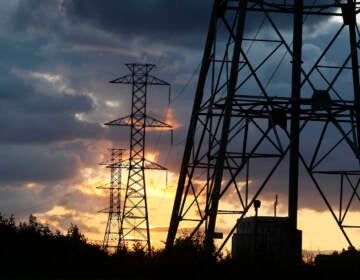PECO rates are rising as the temperature dips. A cold winter is expected
Philadelphia area residents will see jumps in their heating and electric bills. The Public Utility Commission warns against "sticker shock."

A PECO truck is seen in a file photo. (Emma Lee/WHYY)
As energy prices rise nationwide, Philadelphia area residents will see jumps in their heating and electric bills. These increases coincide with what forecasters say will be a cold winter, prompting the Pennsylvania Public Utility Commission to warn against “sticker shock.”
“The upcoming price changes, combined with falling temperatures, make this an important time for consumers and businesses to evaluate their energy options and explore ways to save money and energy in the coming months,” said PUC Chair Gladys Brown Dutrieuille.
The PUC says customers can compare prices on its website, which includes energy-saving tips and a list of electricity providers. Consumer advocates warn, however, that switching providers doesn’t always save money in the long term because some employ variable rates.
Prices for the actual electricity, which makes up about half of the bill, fluctuate twice a year. But starting Dec. 1, some distribution company rates are jumping higher than normal. Pike Company Light and Power rates are rising as high as 50.2%, for example. PECO’s electricity rates will increase 6.4%, which means the average customer who does not use electricity to heat a home will see a jump of about $2.94 a month. Those who do heat with electricity will pay on average an additional $8.40 each month.
In addition to the energy costs, consumers also pay distribution costs. The Public Utility Commission recently approved an increase in that base rate for PECO that would add an additional $6.66 each month to the average household bill, while small commercial customers would pay an additional $25.06. Those increases will kick in Jan. 1, 2022.
PECO will use the additional $132 million to shore up the local energy grid against extreme weather events, provide more funds for low-income ratepayers, support electric vehicle charging stations, and promote clean energy technologies.
“We are committed to delivering safe and reliable energy for our customers and are pleased to have arrived at a balanced settlement with our stakeholders to support our continued investments,” said Mike Innocenzo, PECO president and CEO.
Low-income customers have a number of options to lessen the burden of rate hikes.
“Customers should, if they are low-income, apply for and enroll in the utility’s customer assistance program,” said Rob Ballenger, energy unit director at Community Legal Services. “Because they can provide ongoing discounts on the bill and the opportunity to earn forgiveness of indebtedness incurred prior to enrolling in those programs.”
Ballenger said that in addition to the utility’s own programs, the federally funded LIHEAP program has increased its benefits this year. Homeowners and renters can get up to $2,700 in additional heating assistance whether they use gas, electricity or fuel oil. Renters can also get utility assistance under phase 4 of the emergency rental assistance program, part of the federally funded stimulus package.
 WHYY is one of over 20 news organizations producing Broke in Philly, a collaborative reporting project on solutions to poverty and the city’s push towards economic justice. Follow us at @BrokeInPhilly.
WHYY is one of over 20 news organizations producing Broke in Philly, a collaborative reporting project on solutions to poverty and the city’s push towards economic justice. Follow us at @BrokeInPhilly.
WHYY is your source for fact-based, in-depth journalism and information. As a nonprofit organization, we rely on financial support from readers like you. Please give today.







